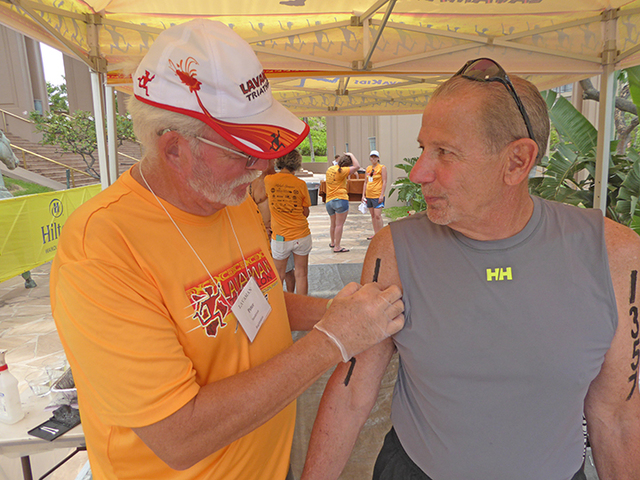Steve Gerbson knows he is lucky to be alive. He acknowledges that every time he recounts the catastrophic medical event that changed his life. ADVERTISING Steve Gerbson knows he is lucky to be alive. He acknowledges that every time he
Steve Gerbson knows he is lucky to be alive. He acknowledges that every time he recounts the catastrophic medical event that changed his life.
In 2013, Gerbson suffered an ascending aortic dissection, a relatively rare occurrence when the inner layer of the aorta — the large blood vessel branching off the heart — tears. Blood surges through the tear, causing the inner and middle layers of the aorta to separate.
“The pain was unbelievable,” Gerbson said. “It felt like a ping pong ball exploded in my chest. My wife asked me if she should take me to the emergency room, and I said no — call 911.”
By trade, Gerbson is a live-television producer and filmmaker in Los Angeles. If this was going to happen, he couldn’t have written a better script. The incident occurred in Santa Fe, New Mexico during a drive with his wife, Olivia, to find furniture for their new house. If it would have happened in LA traffic, Gerbson might not have been as lucky as he was. He recalls the EMTs showing up in just minutes, right before he passed out.
According to the New Mexico Heart Institute, 40 percent of people who have an ascending aortic dissection do not make it to the hospital. Only one in three who make it to the hospital survive, so the incident was far from over. However, he wouldn’t remember much of it. It happened on a Monday and Gerbson woke up on Thursday.
He underwent a nine-hour surgery at the Heart Hospital in Albuquerque. He spent three weeks in the hospital recovering, and went through dialysis because of kidney issues. The path to being whole again seemed like a triathlon of a trek.
“I literally could not pick my finger up off my mattress,” Gerbson said. “It took me a while to even get out of bed and I was fairly depressed. You start looking at your mortality. None of it made sense to me.”
Gerbson has always been athletic, playing football in college and high school and building a lengthy marathon resume that includes Boston, LA and New York.
He knew coming back from this was going to be a different beast, but with his wife’s urging, he started chipping away.
“I got back in the pool, would swim 100 yards and be exhausted,” Gerbson said. “But I was working my way back and feeling better.”
In 2014, another hurdle emerged. Gerbson was told that a previously diagnosed abdominal aortic aneurysm was growing. He needed to be operated on — again.
The initial plan would have put Gerbson back in the hospital for two weeks, with an additional two months of recovery. Then an alternative surfaced.
Enter, Dr. Steve Henao, an endovascular surgeon with the New Mexico Heart Institute. He proposed using stents instead of surgery. It was a relatively new type of procedure, but it meant no huge incisions, and more importantly, minimal recovery time. Just a few hours for the surgery and back in the pool in a week.
The LA doctors advised Gerbson against the surgery, but he did his due diligence and researched Henao. He found an article talking about how the New Mexico Heart Institute doctor saved an 84-year-old retired U.S. Army lieutenant without a pulse from an emergency abdominal aortic rupture without invasive major surgery.
That — coupled with the approval of his loved ones — was enough for Gerbson to pull the trigger on the cutting edge operation.
“I’m a filmmaker — I believe in people’s credits,” laughed Gerbson. “I’ve made a living with high-tech stuff in live-television, so it seemed appropriate. And I didn’t want to get opened up again — that was for sure. I said let’s go for it.”
He hasn’t looked back.
Gerbson has some scars — some he will show you, others he won’t. His nose gets runny and he gets cold easily, but finally he feels whole again. That has brought him to the Big Island for Lavaman Waikoloa this weekend.
“I had always heard about Lavaman and it seems like the perfect distance for me right now,” said Gerbson, who owns a timeshare on the Big Island and has been coming annually for almost a decade.
“I’ve reached the point where I don’t really recognize the person looking back at me in the mirror,” the 65-year-old added. “I want to prove to myself I can do it.”
There are obvious risks involved, but Gerbson received the blessings from his doctors last year to start training. Even more importantly, he got the approval from his wife.
“I wasn’t surprised. It’s in his nature to challenge himself,” Olivia Ayela said. “With the doctors being OK with him doing it, I was fine with it. I just tell him not to worry about his time — just have a good time.”
Steve Gerbson acknowledges not worrying about his time might be an issue, but he knows he’s not here to set any records. Instead, he hopes his comeback story — which will be documented by a film crew — will help someone in a similar situation.
“You put things in perspective and examine who you are and what you have gone through after something like this,” Gerbson said. “I hope my story can offer another patient some sort of solace or encouragement that if they have a catastrophic medical event, life isn’t over. You can become whole again — I’m as whole as I ever was.”



